
Features
Continuing Education
Education
The Power of Birth
Birth is the culmination of an incredible period of growth and development in the life of a woman and her family. Along with the wondrous physical, psychological, and spiritual changes that occur in the pregnancy, the woman then has a transforming event which will fundamentally change her life activities, goals, thoughts, career aspirations, and plans for the future.
September 18, 2009 By Cindy Mcneely
Birth is the culmination of an incredible period of growth and development in the life of a woman and her family. Along with the wondrous physical, psychological, and spiritual changes that occur in the pregnancy, the woman then has a transforming event which will fundamentally change her life activities, goals, thoughts, career aspirations, and plans for the future.
As Massage Therapists, we are both witnesses and participants in the unfolding events of our clients lives through their lifespan. Nowhere does our contribution become more profound than in the births and deaths of our clients and their families. For many therapists, attending the birth(s) of a client(s) may be the highlight of their professional career.
 |
|
|
The chances are high that every MT in practice will at some time in their clinical practice acquire clients who become or are pregnant. This is true whether the therapist creates a general practice or chooses to specialize in sports injury, trauma, chronic illness, or spa treatments.
The skills of the Massage Therapist working with pregnant clients need to be enhanced beyond a basic understanding of pregnancy anatomy, technique and treatment application. The variation in pregnancy training in colleges throughout the world create a disparate capability amongst Massage Therapists regarding their skill level in prenatal care.
Many Canadian Massage Therapists can be extremely proud that they have attended colleges which have given them the best training in the world – including their pregnancy, and post-pregnancy knowledge. Each therapist has to understand the degree of comprehensivenesss of the training they have received, the philosophical approach their instructors have taken toward the area, and if needed, seek out post-graduate training that will pr pare them thoroughly for the trust and wide-ranging concerns their pregnant clients will approach them with.

|
|
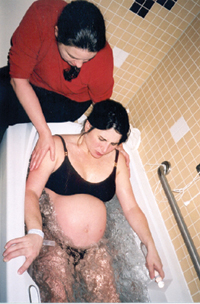 |
|
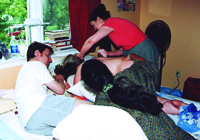 |
|
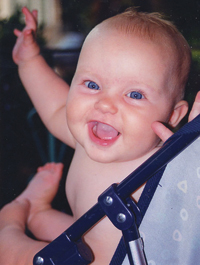 |
|
|
|
It is not sufficient to simply learn about the anatomical, physiological, and structural elements that apply to the pregnant woman. These subjects, while fascinating when compared to the non-pregnant person can lead us into a ‘pathological’ attitude toward the condition of pregnancy.
Instead, when trained to understand the holistic process that begins from the moment a woman becomes capable of conceiving, the therapist can understand and approach her or his clients from a state which conjoins the woman in a sharing of the profoundness of the days and months ahead.
The ultimate luxury of our Massage Therapy profession is the factor of time. To spend an hour or an hour and a half with each client every visit, sometimes weekly, sometimes bi-monthly, or in the early stages of pregnancy perhaps once a month, gives the MT the opportunity to explore each woman’s pregnancy with an intimacy that she often does not have with anyone other than her partner – certainly most often with more connection than she has with her primary healthcare provider whether obstetrician, physician, or midwife.
The confidence and comfort that we bring to each treatment, ensures that our clients are able to grow with their changing body in ways that prepare them for their upcoming birth. We hold a great responsibility in our hands to nurture our clients at this time of great strength and vulnerability.
Pregnant clients are incredibly educated these days. Not content to passively ‘lie in wait’ for the big day, women are reading from the mass of pregnancy material on the market, taking prenatal exercise classes which include but are not limited to yoga, aquafit, and belly dancing. They are receiving bodywork in Massage Therapy, Shiatsu, Chinese Medicine, Homeopathy, to name a few. They attend prenatal classes, hypnobirthing preparation, massage preparation for birth. They find information and MTs by exploring the Internet. They actively consult others regarding who they will choose as their primary careprovider, where they want to give birth, and who they want to be present during their birthing process. Women are knowledgeable consumers who want the best for their babies and themselves.
Imagine having a career where one is inspired by the enormous responsibility of helping women and their families succeed in having happy and healthy birthing experiences through the provision of Massage Therapy. This would summarize the role of the Massage Therapist in attending births.
Many people are still unfamiliar with the word “Doula” – indeed even some Doulas wish the term was more self-explanatory. For purposes of clarity, this article will use Labour Support Provider and Doula as interchangeable titles to the same role.
So what, exactly does a labour support provider do, and how do we, as Massage Therapists fit into this spectrum of care? By definition Doula/Labour Support Providers are people who attend to the birthing process of their clients in a way that provides ‘continuous and supportive care.’
Clearly this demands a more intensive commitment and therapeutic interchange than that required in a one-hour massage therapy session.
Being asked to attend a birth is an honour bestowed from families who demonstrate a faith, trust, and desire to engage the personal and professional skills of the attendant. It is not for the faint of heart, nor for those who are unable to give themselves to the commitment of long hours, physically and emotionally challenging work, as well as to engage in the incredible beauty that is involved in participating in
helping a tiny, beautiful new person enter into the world.
When I attend the births of my clients, invariably there are moments or hours where I am filled with awe of the courage and spirit of my families, and in particular the women who are giving birth. There is no mistaking the profound efforts of women who work so painstakingly to bring their babies into the world.
Many MTs become Labour Support Providers for their clients as a result of their intense curiosity and desire to learn about and understand the birthing process, and from a hope to assist families in their goals for a wholistic and pleasurable outcome to this journey.
Historically, many MTs/Doulas fell into the situation of attending births without formalized training. They may have dared to utter the words out loud: “I would love to attend a birth some day.” These words echoed into the thought processes of our clients, who would consult with their partner, return for another prenatal massage visit, and ask the question which resonated into another echo: “Would you attend the birth of our child with us?”
With no other background than the exquisite hands-on knowledge of Massage Therapists, we might be sufficiently helpful in creating positive birth outcomes. However, the day comes quickly when all M.T.’s attending births reach a clear understanding that further training is necessary to make them the best Labour Support Provider possible.
We can all be thankful for the role Doulas of North America (D.O.N.A.) has played in providing courses for laypeople and professionals alike with an aim of improving our understanding and sensitivity to the skills that are needed to provide family-centred care while working within the multi-disciplinary milieu of birth.
Labour Support Providers (LSPs) need to be prepared to work in an array of settings – in Canada, hospital or home births are the norm. Sadly to date, birthing centres have not taken hold in this country. LSPs must be able to work comfortably with Midwives, Obstetricians, Family Physicians, and with Nurses, with Anesthesiologists, with midwifery and resident students in training, with about-to-be fathers, same-sex partners, and the endless possible variations of what constitutes ‘family/friends’ of the birthing family.
What inherent traits are needed to prepare us for this time of magical intensity?
- Patience.
- Faith and belief in the potential, strength, and capability of human beings to give birth naturally and without interference.
- Willingness to connect and share the best aspects of ourselves with our clients and other participants in their birth in order to promote the primary goal – a healthy, happy birth outcome.
- An endless flexibility to go with the flow, respecting the birth choices of the family, whatever their decisions which will ultimately influence the outcome of their birth.
- An indefatigable demeanour even when we are hardly able to disguise our fatigue.
- Commitment to clients in a strong, unwavering way.
- Joy – in being able to witness power, great strength, and at times, intense pain.
The photos which are included in this article are a testament to the magnificent characteristics of the birthing families who have entrusted their stories to be shared with the reader. It is my hope that through text and visuals, the reader will have a clearer sense of both the birthing experience, and the role played by the MT/LSP.
When the family requests labour support care, a contract is usually drawn up between the family and the MT This essentially outlines the responsibilities and commitments of the MT. Items such as specific dates that one is available to be on-call for the birth, at what point the doula will come to hospital or home to attend the labour, what her tasks can include and what they do not.
Many people think the role of doula and midwife are synonymous but it must be made extremely clear that the doula does not take part in any of the obstetrical tasks involved in the pregnancy or actual birthing of the baby. Instead, the doula provides support with the physical and emotional aspects of breathing, relaxation, massage, position changes, and hydrotherapy provision and phone numbers, and how long she will remain with the family after the birth occurs. Many doulas go to home or hospital when contractions are consistently five minutes apart, and leave the new family approximately one to two hours after the baby has been born.
In the days leading up to the due date (EDD = expected date of delivery), the LSP is often in daily contact to check in on any changes in the progress toward labour, and to provide reassuring support at this time of high expectation.
The LSP asks to be informed of any signs indicating a shift toward labour. These signs may be of a minor nature such as low back achiness similar to the onset of a menstrual period, or an increase in the intensity or frequency of the ‘preparatory contractions known as Braxton Hicks. It could also be indicated through an increased desire to perform household tasks such as cleaning closets and washing floors and walls which can occur in the final stages of pregnancy (not in all impending birthing women, however!!!) and which has become known as the ‘nesting urge.’
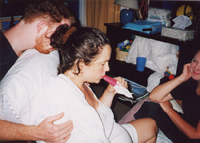 |
|
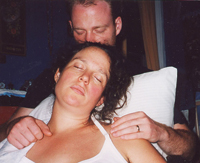 |
|
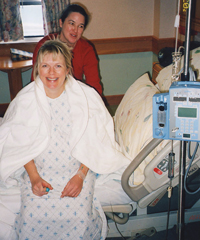 |
|
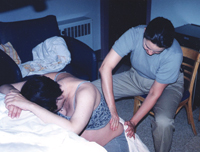 |
|
|
|
More indicative indications of the upcoming onset of labour would be the physiological changes the woman undergoes such as discharge of the mucus plug or a ‘bloody show’ although there can still be days which will pass. Rupture of the membranes (ROM), and/or contractions that become ‘longer, stronger, and closer together’ are signals that the birthing process is becoming more active.
Labour is divided into phases and the first stage is known as the “Early or Latent” phase. For families giving birth for the first time, this can kick start an intense level of excitement, expectation, and in some cases may be a time for some anxiety. The most frequently asked question in the last few weeks of pregnancy is often: “How will I know when my labour has truly begun?” It is no consolation to be greeted with: “You’ll know!” even though this is really the only adequate answer that often can be given, aside from the events listed above.
During this early phase of labour, which can last from a few to 20 hours, it is important that the family relax as much as possible, and keep activities as normalized as they can. Taking baths, going for walks, watching a movie and, above all, practicing relaxation and strategies that maximize rest are crucial for the journey ahead.
Since contractions are not consistently regular at this point, it is an excellent time for the partner to practice those massage techniques that they learned in the prenatal class, or in the offices of the MT during their “massage for labour tutorial.” Doulas want to know when this early stage is occurring, and most LSPs carry a pager for this purpose. Most, however, do not arrive for this stage unless requested by the family because it is important that the LSP provide excellent care during the more intense or ‘active stage’ of the birthing process, providing a rested and energized presence at that time.
Fatigue and over-excitement are challenges for the family and careproviders at this early stage, and anything that helps maintain a calm and restful atmosphere is the desired goal at this point in the birthing process.
The time will come when contractions do become more intense – often the woman has to pause through them, and is unable to speak while they are occurring. The family consults in advance of the due date with the primary careprovider for guidance as to when they should leave for the hospital, or inform the midwife about the progression of these contractions in the event of a home birth.
At this point the contractions have increased in their frequency, in their intensity, and in their duration. This is the Active Stage of Labour, can last several hours, and is an important time for women and their partners to have as much support as possible.
The goal of the LSP is to provide support in a way that is as unobtrusive as the family wishes. There are many possibilities for this phase of the labour – some quite interactive, and some very low key and subtle.
Many of these have been discussed with the family in advance as a preparation for the birthing experience. Some examples are noted in the photos which include:
- utilizing water, whether with a shower or bath (children’s swimming pools make excellent birthing tubs!);
- ensuring the woman (and her partner) stay hydrated and nourished as per the physician/midwife suggestions;
- position changes – may be upright and walking, swaying, slow dancing with her partner, on all fours doing the cat stretch or rocking movements, kneeling over a bed, a banister or a birthing ball, side-lying, or semi-reclining;
- touch and massage therapy with a goal to provide a reassuring physical contact, increase comfort and decrease pain, and remind the woman to release any tension that may accumulate in her body due to the contractions.
The most important element of the LSP’s job at this point is reassurance and encouragement, providing as much comfort as possible, and facilitating the woman in reaching an internal/external state of deep trust in her body to birth her baby.
This may involve creating the environment for a restful, relaxing experience more than anything else. Dimming the lights, providing music that the woman loves, ensuring there are no distractions which take the woman away from her birthing work ie. noise, interruptions, questions, may be the most important accomplishment of the LSP.
I once had a nurse come into my client’s birthing room in the hospital, and as she whisked through the door, she suddenly paused, slowed down her pace, and said: “I feel like the Tasmanian Devil who comes whooshing into this room which is so beautifully calm and peaceful – such a contrast to what is going on in the unit outside.”
Similar to the environment that many Massage Therapists attempt to create in their practices, a peaceful birth place creates a peaceful family. Much of the work of Labour Support involves waiting and a wordless presence. If our birthing clients reach a state of internal calm (again a mirror of the deepest states of relaxation on the massage table), then everyone’s work is easier.
There are indications that it is in this state that the natural endorphins of the woman are released providing an amazingly effective sense of pain relief.
It is my belief that if more women were taught pre-natally to facilitate the release of these endorphins through visualization, vocalization, and through breathing, women would be much more confident in their capabilities to birth without ‘needing’ epidurals or other medications to ‘get them through’ the process.
Most families love to hear the words 10 cm dilated because it is at this point that the woman will begin the second stage of labour which is the pushing phase.
There are various ways to facilitate the entry of the baby into the world. These can vary from waiting for the woman’s spontaneous urge to push, or to have the primary careproviders actively coach the woman in her efforts in conjunction with uterine contractions. This can be an intense but very rewarding effort since the woman or her partner will eventually witness ‘crowning’ of the baby’s head on the perineum. It is a welcome sight to see the tufts of hair or little head that appears at this time.
Some fathers look forward to watching their baby’s enter the world with a hope to actually ‘catch the baby,’ while others are more content to remain at the head of their partner, encouraging them in their efforts to ‘bear down’ and deliver their baby.
The LSP is often in active use at this point – they may be helping to support a leg, massaging the neck in between contractions, vocalizing their support during the pushing, or reminding their client to relax and release tension at times when they are not pushing.
At last, the baby arrives!!!! – a time of relief, elation, and celebration. The baby will be assessed for state of health but may be immediately placed on the mother’s chest or abdomen to ensure that those supreme first minutes are spent in close contact with the woman and her partner. The energy in the room at that time can be incredibly heightened, and the doula will meld into the situation as appropriate.
Many woman have high hopes and expectations of their birthing process often having created a birth plan that mirrors these desires. Sometimes events occur either during the pregnancy or birth that result in a change in the anticipated outcome. Examples of this during pregnancy could be the onset of high blood pressure (also known as pre-eclampsia), the experience of preterm labour, the position of the baby at term in a breech position, or the decision of the careprovider to induce labour if the woman has gone past 41 weeks of her pregnancy.
During the birthing process the baby may not ‘descend’ as per the expectation of the careprovider, the baby may show indications of fetal distress, the woman may decide after all that she wants an epidural either due to the length of labour and her fatigue level, or due to a pain level higher than she feels able to tolerate.
The doula maintains a supportive role regardless of the situation encouraging the family in any way possible.
Having an epidural or a C-section does not preclude the presence of the LSP. There are hospital policies or attitudes of the careproviders however that may make the continuous presence of the doula more challenging.
Constant consultation with the family and staff, the professionalism, flexibility, and calm attitude of the doula goes a long way during these situations to ensure they remain a valued part of the team.
It’s exciting to have families give you feedback after the birth, and the wonderful aspect of the Massage Therapist as doula is that she/he can provide Postpartum Massage and Infant Massage Instruction whenever requested by the family. This is a very worthwhile benefit for families – not only because of the obvious physical and emotional aspects of our work, but also because it once again gives time for the family to discuss their experiences, ask questions, and process their experiences with someone who understands and was present during the unfolding events of the baby’s entry into the world.
There is no greater satisfaction than hearing words such as: “We couldn’t have done it without you, we will always remember you or whenever we celebrate the birth of our baby, the impact of your presence will be a part of it.”
As well, having comments from midwives and obstetricians such as: “Thank you so much for your contribution during the birth or you were a very big help during X’s birth” can’t help but add to the sense of commitment and pride one feels in one’s massage and labour support work.
To conclude this article, I am including a quote from a recent client. I had contracted to attend their birth, however due to the SARS outbreak, no Labour Support Providers were allowed into the hospital at the time that they went into labour. Despite that, and because of the fact, that I had an ongoing therapeutic relationship with this client during her pregnancy, I received a thank you card regardless. This is what it said:
“Hi Cindy: We just wanted to drop you a line to thank you so much for your support and guidance during our pregnancy. The massages were a life saver, but even more than that, it was so wonderful having you in our corner as the big day drew near. It was such a shame you couldn’t be with us during labour, but with your help we felt really relaxed and prepared. Thank you for helping to make the whole pregnancy and labour such a positive, enriching experience. Your generosity was amazing … P.S. We will be in touch soon about infant massage!!!!!”
Print this page